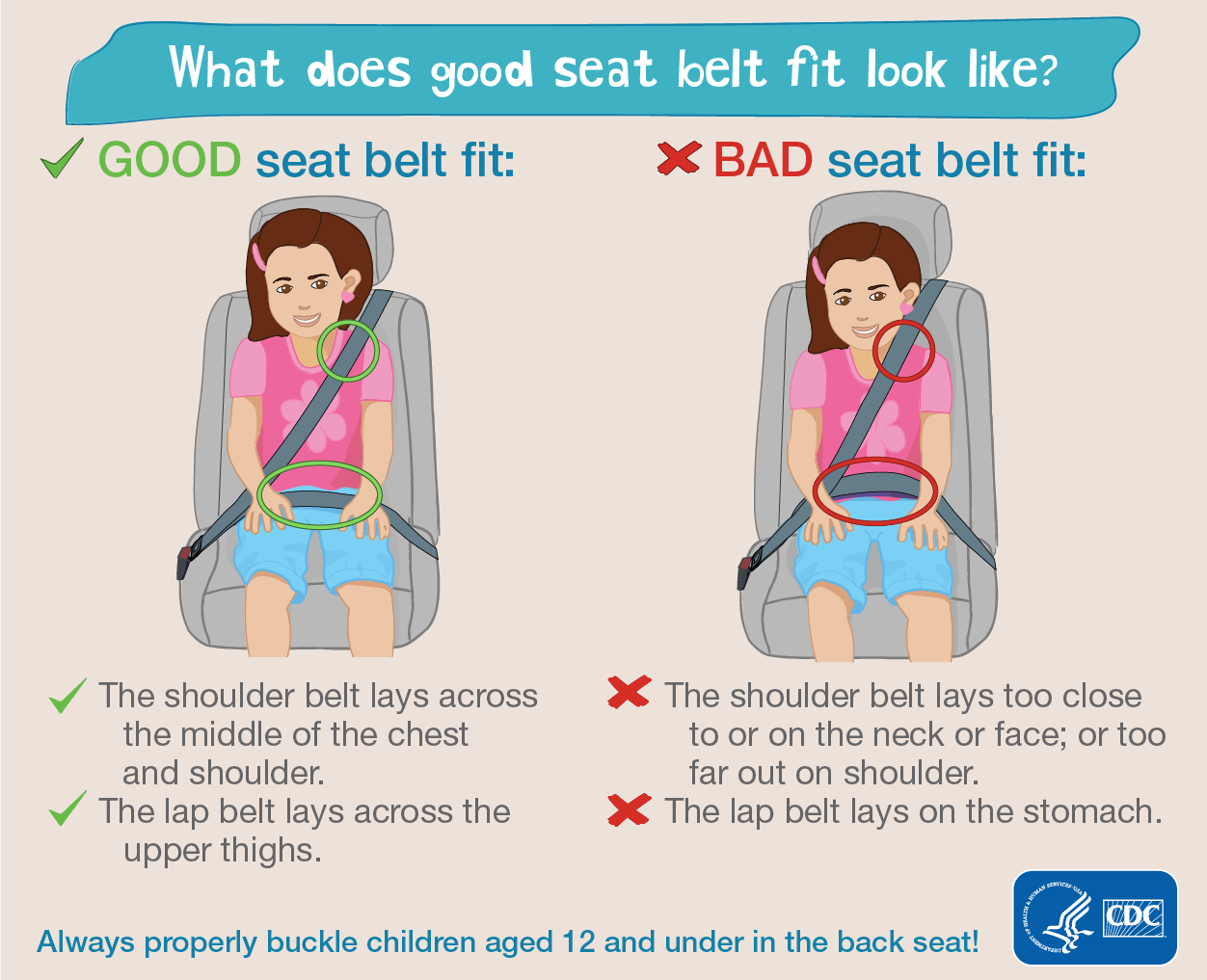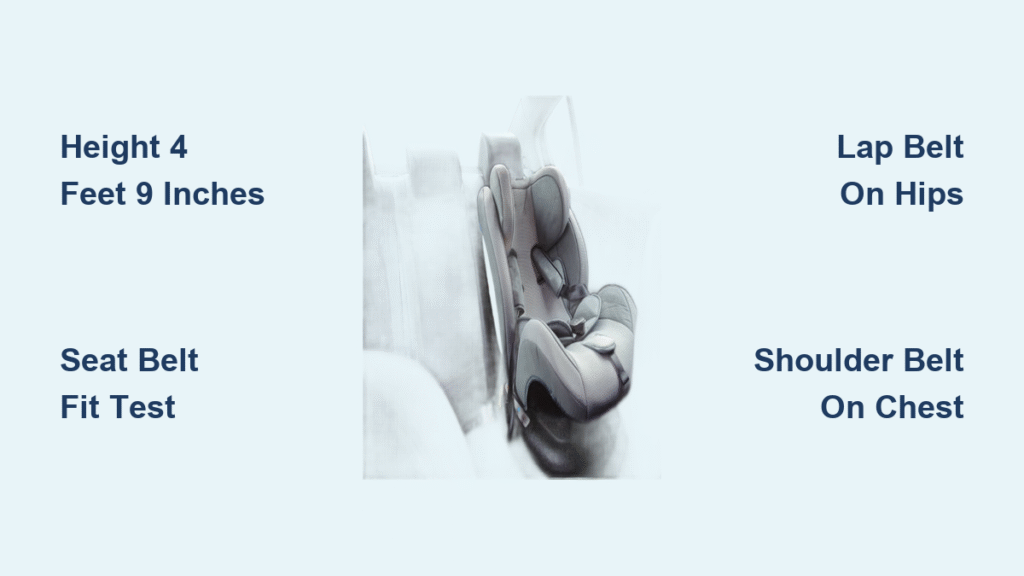That moment when your child begs to ditch the booster seat feels like a rite of passage—like they’re finally shedding the last vestiges of babyhood. But here’s the hard truth no one tells you: age alone shouldn’t determine when kids stop using car seats. Rushing this transition could leave your child dangerously unprotected in a crash. The critical factor isn’t their birthday—it’s whether the vehicle’s seat belt fits their body correctly. For most children, this happens between ages 8 and 12, but pushing too early based solely on age puts them at serious risk. Let’s cut through the confusion with science-backed guidelines that actually keep your child safe.
Most parents operate under the myth that turning 8 automatically means booster freedom. But safety experts and vehicle engineers agree: a child needs a booster seat until they reach 4 feet 9 inches tall and pass a simple seat belt fit test. Why? At this height, the lap belt naturally rests across the strong pelvic bones instead of the soft abdomen, while the shoulder belt crosses the center of the chest—not the neck or face. Skipping this crucial step leaves kids vulnerable to severe injuries during even moderate collisions. In this guide, you’ll learn exactly how to determine booster readiness using the five-step test doctors and safety organizations recommend.
Height Determines Seat Belt Safety, Not Age

Your child’s height—not their age—is the non-negotiable factor for safe seat belt use. The 4 feet 9 inches threshold exists because vehicle seat belts are engineered for adult proportions. Below this height, the lap belt rides too high on the abdomen during impact, transferring crash forces to vulnerable internal organs instead of the stronger hip bones. Simultaneously, the shoulder belt often crosses the neck or face, becoming a strangulation hazard rather than a restraint.
Consider this: a petite 10-year-old who’s only 4 feet 5 inches tall needs a booster more than a tall 7-year-old hitting 4 feet 10 inches. Growth spurts vary wildly, and your vehicle’s seat design plays a role too. Always measure your child standing against a wall with a pencil mark—don’t guess. If their eyes don’t reach the top of your car seat headrest, they almost certainly need continued booster protection regardless of what their driver’s license age might be.
When Shorter Children Need Extended Booster Use
Children under 4 feet 9 inches should never ride without a booster, even if they’ve turned 8 or 10. Their smaller frames mean seat belts can’t position correctly across the body’s strongest points. Watch for these critical signs in your vehicle:
– The shoulder belt constantly slips off their shoulder
– They slump sideways to avoid belt pressure on their neck
– The lap belt rides up over their stomach when seated normally
– Their knees bend sharply instead of resting comfortably at the seat edge
If any of these occur, keep the booster seat installed. It’s not about babying them—it’s about physics. In a 30-mph collision (common in residential areas), an ill-fitting seat belt can generate enough force to cause internal injuries to unprotected abdominal areas.
The Five-Second Seat Belt Fit Test That Saves Lives
Before removing the booster, perform this mandatory safety check with your child seated in their regular position. All five steps must pass simultaneously—failing even one means the booster stays. Have your child sit normally (no slouching!) for the entire test.
Proper Back Support Position
Your child must sit fully against the vehicle seat back without leaning forward or curling legs under them. If they naturally slide into a “W” position or perch on the seat edge, their torso isn’t stabilized. This compromises the seat belt’s ability to distribute crash forces. Tip: Ask them to sit like they’re watching a movie—they shouldn’t need to crane their neck to see forward.
Lap Belt Placement Check
The lap belt must lie flat and snug across the upper thighs, touching the hip bones. Press down gently on the belt to confirm it doesn’t ride up toward the abdomen. If you can fit two fingers under the belt at the waistline, it’s too loose. Crucially, the belt should never rest on the soft stomach area—that’s where life-threatening internal injuries occur during crashes.
Shoulder Belt Alignment Verification
The shoulder portion must cross the center of the chest and middle of the shoulder, staying clear of the neck and face. Have your child turn their head side-to-side; the belt shouldn’t dig into their throat or slide off the shoulder entirely. If it crosses near the ear or collarbone, your child lacks the torso height needed for safe seat belt use.
Natural Knee Bend Assessment
With their back flat against the seat, your child’s knees should bend comfortably over the front edge of the seat cushion. Feet must rest flat on the floor without stretching. Dangling legs or knees pulled up indicate insufficient leg length to maintain proper posture during impact—a major red flag for ejection risk.
Trip-Long Posture Maintenance
This is the hardest step for kids: They must hold the correct position for the entire ride duration without slouching, tucking the shoulder belt behind them, or lifting the lap belt. Have them practice during short drives. If they fidget within 5 minutes, they’re not ready. Real talk: Many 11-year-olds still fail this step due to growing pains or distraction.
State Laws vs. Crash Physics: Why Minimums Aren’t Safe
While all 50 states require booster seats through certain ages, legal minimums don’t equal safety minimums. Most laws (like California and New York’s requirement until age 8 or 4’9″) represent the bare legal threshold—not what crash tests prove is safe. A child meeting the age requirement but failing the seat belt fit test has 3x higher injury risk in crashes according to traffic safety data.
Critical Law Variations to Check
- Age-based laws: 20 states mandate boosters only until age 4-8 (ignoring height)
- Height-based laws: 15 states require boosters until 4’9″ regardless of age
- Weight loopholes: Some states allow seat belt use at 40+ pounds (dangerously low)
Always verify your state’s current regulations through official DMV channels—but remember: laws lag behind safety research by 5-10 years. If your state allows seat belts at age 7 but your child is 4’2″, keep the booster. Your insurance company won’t care about legal compliance if your child gets injured because the belt didn’t fit.
Why Premature Booster Removal Risks Catastrophic Injury

Removing the booster too early creates what safety engineers call “seat belt misfit”—where the restraint system works against the child during impact. In frontal collisions (the most common type), an ill-positioned lap belt can cause:
– Abdominal compression injuries to intestines and liver
– Spinal trauma from the shoulder belt yanking the neck
– Submarining—where the child slides under the lap belt during impact
Booster seats solve this by elevating the child so the seat belt crosses anatomical strong points. Without this elevation, crash forces concentrate on the weakest areas. Research shows children using seat belts before proper fit have injury rates comparable to unrestrained children in moderate-speed crashes. That “big kid” milestone isn’t worth gambling with spinal cord safety.
Vehicle-Specific Fit Checks You’re Probably Skipping

Your child might pass the seat belt test in your SUV but fail in your sedan—seat design dramatically affects fit. Captain’s chairs with deep cushions, bench seats with sloped backs, and even headrest positions alter belt geometry. Always retest in:
– Family members’ vehicles
– Ride-share cars
– School buses (if applicable)
– Rental cars during vacations
Perform the five-step test each time they ride in a new vehicle model. That booster seat in Grandma’s trunk? It’s not optional—it’s essential until you verify fit. Many parents discover their child needs boosters longer in vehicles with aggressive seat bolsters or high seat bases.
Smart Transition Protocol for Final Booster Removal
When your child finally passes all five steps, don’t celebrate with an immediate road trip. Implement this two-week transition protocol:
1. Dry-run in driveway: Practice 10x with engine off until posture is automatic
2. Short-trip trials: Only allow booster-free rides under 15 minutes initially
3. Seat belt audits: Randomly check belt position mid-ride (shoulder belt centered, lap belt tight on thighs)
4. Posture rewards: Praise maintaining position (“Great job keeping your feet flat!”)
Keep the booster seat accessible for the first month. If they fail any check (like slouching on a long drive), revert to booster use immediately. True readiness isn’t passing once—it’s consistency through fatigue, sleepiness, and distractions.
The Height-First Checklist for Booster Graduation
Before storing that booster seat, verify these non-negotiable criteria:
– [ ] Child measures at least 4 feet 9 inches barefoot against wall
– [ ] Passes all five seat belt fit steps simultaneously in your vehicle
– [ ] Maintains position for minimum 30-minute drive without reminders
– [ ] Fits properly in every vehicle they regularly ride in
– [ ] Meets or exceeds your state’s legal requirements (check DMV site)
When every box is checked, your child has earned true seat belt readiness—not just a birthday milestone. Until then, that booster seat isn’t a baby item; it’s a life-saving device calibrated for their developing body. The few extra months of booster use could mean the difference between walking away from a crash and lifelong injuries. Safety isn’t about age—it’s about anatomy. Measure first, celebrate later.





